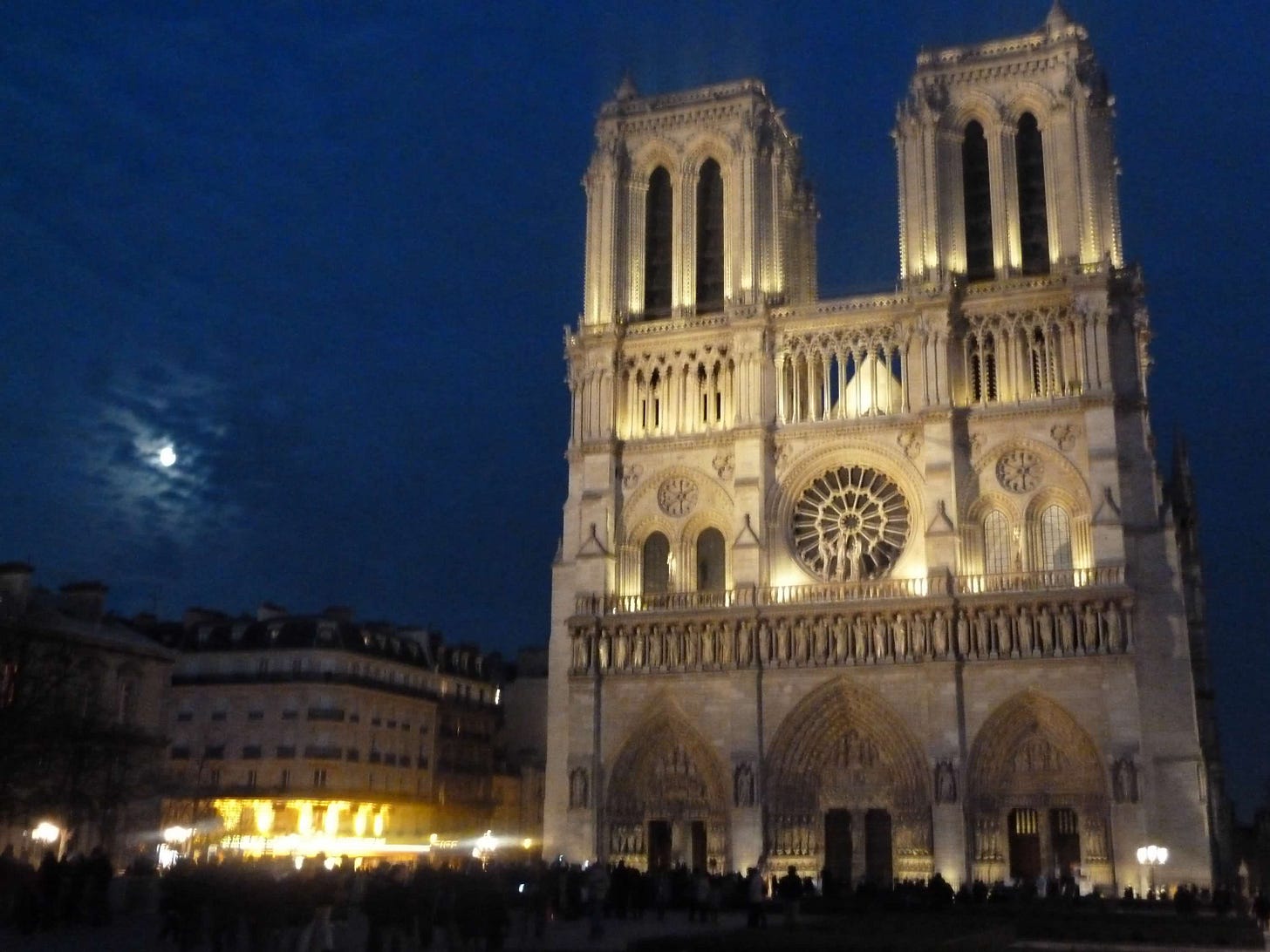What Notre-Dame Can Teach Us About Surviving in Challenging Times
The Hope and Resistance Series: Stories from the Global Writers' Group Showcase
Over this next weeks, we will be sharing pieces from our annual Global Writers’ Group Showcase with you all. Please visit our substack to view the entire series
By Barbara Noe Kennedy
My friend Denise texted me from Paris: Notre-Dame is burning!
Confused, I turned on my TV, and the sight stole my breath. Flames engulfed the ancient Gothic masterpiece like a ravenous predator, and the iconic spire swayed precariously, moments away from collapse.
How could this be?
I texted my French parents in disbelief. Muguette replied almost instantly: “A horror, it’s a horror.”
I watched the famous ancient cathedral face what seemed to be her final moments, and conflicting thoughts raced through my mind.
Today’s French are famously secular. According to a 2023 survey, only 12% attend church—my French parents don’t. And yet, like millions of others, they were transfixed and heartbroken at the devastating loss of … a church.
Notre-Dame de Paris was built between 1163 and 1345, the world’s second great Gothic cathedral after St.-Denis. Mind you, this was a marvel of human achievement, a bold architectural feat reaching heaven itself. Flying buttresses, pointed arches, and barrel vaults supported its soaring walls and immense stained-glass windows, defining the Gothic aesthetic and making its grandeur possible. Scores of master stonemasons, carpenters, and glassmakers transformed raw materials into an awe-inspiring structure, taking immense pride in their work.
And yet, Notre-Dame was not built purely as a symbol of faith—not for the common people, at least. Her soaring heights and intricate facade served as a 24/7 reminder of the Church’s authority in the lives of medieval Parisians, many of whom barely scraped by. The gargoyles, ostensibly to ward off demons, doubled as warnings to stay within the Church’s oppressive embrace. The stained-glass windows, celebrated for their artistic achievement, reinforced biblical narratives for an illiterate population, underscoring the Church’s control over salvation and eternal judgement. Through the centuries, she served as a symbol of subjugation and imperialism—capped by Napoleon’s self-coronation in 1804 as emperor beneath her lofty vaults, a defining moment of imperial power staged in her sacred space.
So why, then, were the secular Parisians, alongside millions of others, so devastated by the 2019 fire? Why mourn a structure rooted in centuries of imperialism and oppression?
Because, I believe, there’s more to Notre-Dame than her historical associations with power and control. Beneath her Gothic arches lies a deeper, transcendent essence. She was built on the site of a foundation steeped in ancient spirituality, a site revered long before empire—and Christianity—arrived. The Celtic Parisii once worshipped here, drawn to the energy of this river-embraced sanctuary, honoring their animal deities. Later, the Romans, at the height of their power, erected a temple on the same spot. Isn’t that part of her allure, her almost tangible sense of the divine?
And then there’s her story of survival. Through the centuries, Notre-Dame has borne witness to the rise and fall of empires, revolutions, and wars. She was ravaged during the French Revolution, her statues and treasures destroyed. She fell into decay in the 19th century, nearly lost until Victor Hugo’s The Hunchback of Notre-Dame renewed public interest in her preservation. She survived the Siege of Paris in 1870, the Nazi occupation during World War II, and the devastating fire of 2019.
Jesus once said, “Render unto Caesar the things that are Caesar’s, and to God the things that are God’s” (Matthew 22:21). That is, do what you must on this earth to survive, but remember that your ultimate loyalty remains with God. This is the paradox of Notre-Dame: a worldly structure of obligations and power and all of the other messy human stuff, imbued with a divine presence. She is a symbol of empire that transcends her origins to evoke a deeper, universal connection to something greater than ourselves.
In the five years since Notre-Dame’s inferno, she has been rebuilt using the same ancient techniques that brought her to life—and she shines anew, looking just as she must have when she first opened her doors nearly a millennium ago. This achievement is a testament to the extraordinary craftsmanship of workers dedicated to preserving her historical authenticity, of the massive fundraising effort, of the collective desire to re-create this iconic structure. And yet, it’s more than that.
Notre-Dame endures because she is more than stone and glass, more than a church or a relic of empire. She exists beyond the mortal realm, reminding us of our capacity for both destruction and renewal—and of the sacred that persists, even in the shadow of oppression.
Read the rest of the series:
I Stopped Because It Hurt
Over this next week, we will be sharing pieces from our annual Global Writers’ Group Showcase with you all.
I've Always Done My Best Work Out of Spite
Over this next week, we will be sharing pieces from our annual Global Writers’ Group Showcase with you all.
Watch the entire evening here:
For more information or to join the Global Writers’ Group, click here. We’d love for you to join us!
The Narrative Gap, as coined by Lisa Sharon Harper, is the distance between the stories that we tell ourselves about ourselves, including how we got here and what it will take to make things right. In our world today, competing narratives vie for our loyalty, dividing society and the church, therefore making justice impossible. Our mission is help communities shrink the narrative gap, by identifying core issues and building community capacity so they might work toward common solutions for a just world. Here on the Freedom Road Substack, we can converse together on ways to shrink that narrative gap and help ensure everyones’ stories are told.
Connect
Freedom Road Instagram | Facebook | Threads | Website | Patreon | Podcast






